We all learned about Hippos from our childhood. We know that this semi-aquatic species is illustrious around the world for its uniqueness. If you happen to roam around in the African safari, you will notice that hippos are one of the easiest animals to spot.
However, Pygmy Hippos, the smaller cousins of common hippos, are challenging to catch on eyes. You might have taken time to wonder, can you adopt or take a pygmy hippo pet? Well, the answer depends upon various factors.

The origin of Pygmy Hippo
The term hippopotamus comes from the Greek word for “water horse.” This name provides a fitting definition for the pygmy hippo, as they spend most of their time grazing in rivers or swamps. The pygmy hippo is the only living survivor of the Hippopotamidae tribe. They resemble pigs and tapirs, but interestingly their nearest living counterparts are cetaceans such as whales and dolphins.
Pygmy hippos are native to the humid forests of West Africa. The majority of the approximate 2,000 pygmy hippos left in the wild are believed to be in Liberia. Countries like Sierra Leone, Ivory Coast, and Guinea are also home to smaller numbers of Pygmy Hippopotamuses. In case you weren’t aware of these facts; we call a male pygmy hippopotamus a bull, the female is called a cow, and a child is known as a calf.
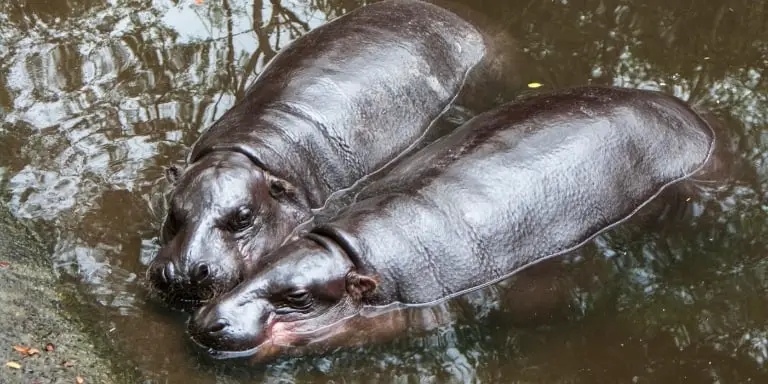
Distribution of Pygmy Hippo

Numerous factors pose a threat to Dwarf Hippopotamuses that continue to contribute to dwindling numbers. The most significant danger to pygmy hippoptami is habitat destruction and degradation, which has occurred when woods have been used for logging, cultivation, plantations, and other agribusiness uses. Often, they are threatened by hunters for meat.
The habitat of the pygmy hippo does not share its domain with the common hippopotamus. In many areas, such as in isolated Nigeria, the population of Pygmy Hippo is believed to be extinct since there have been no reported sightings of this distinct subspecies for decades. Recent anecdotal reports from locals provide some hope that they might still survive.
The Nature of Pygmy Hippo
In general, a Dwarf Hippo is half the size of a common hippopotamus. It weighs less than a quarter of its larger cousin. A fully grown Dwarf Hippo measures up to 100 cm tall. Its length can range from 4.92 to 5.74 ft long and weighs around 180–275 kg.
Pygmy Hippos have the same peculiar secretion as their cousins, which gives their bodies a reddish color. It is often referred to as “blood sweat.” Even though the secretion is neither sweat nor blood, this fluid is thought to have antiseptic and sun-protective qualities.
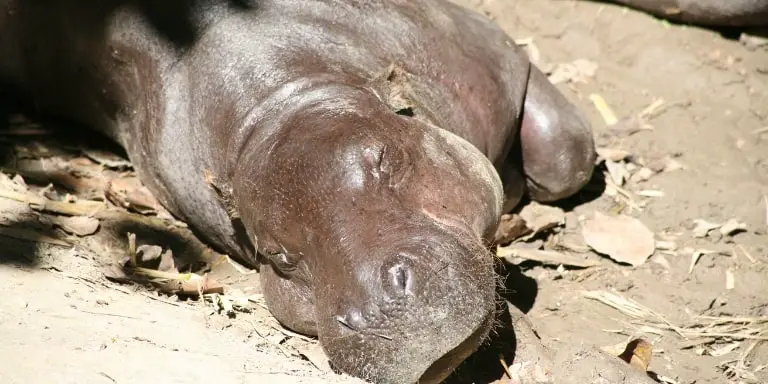
Traits and behavior
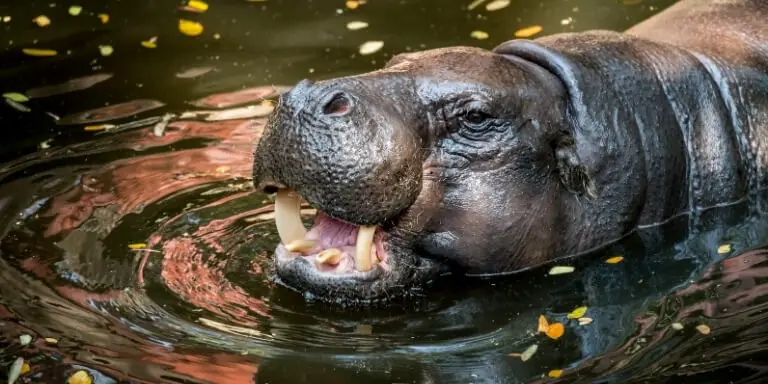
The behavior of the pygmy hippo varies significantly from that of the common hippo. Most of its action resembles that of a tapir and is the product of convergent evolution.
While the common hippopotamus lives in large numbers, dwarf hippos prefer to live alone or in tiny groups, either with a mated pair or a mother and calf. When pygmy hippos interact, they prefer to avoid each other rather than war.
They spend most of their time in swamps and around waterways to keep their skin moist and feed on surrounding leafy plants later in the day and at night. As strange as it may seem, but pygmy hippos can’t swim in the water. Instead, they sink down the water before rising to the surface. Instead of swimming, they tend to prefer walking underwater.
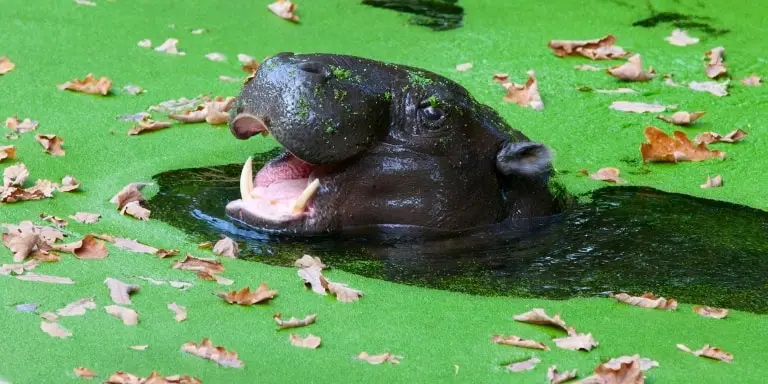
Can Pygmy Hippos kill humans?
A Hippo, with its massive weight, can easily choke a person to death. Similarly, when the situation calls for it, pygmy hippos can also become mean. In general, They are not as dangerous as their larger cousins.
However, they resort to aggression when time demands for it. Whenever animals invade their territory, they become aggressive to defend their family. Hence, it is better not to put yourself between a pygmy hippo and water, and interfere in their activities.
Food Habits
Pygmy hippos are herbivores; they eat a wide range of food, including leaves, dropped fruit, roots, and tubers fallen from above branches. They tear aquatic plants and foliage with their solid, muscular lips rather than their teeth. Under the shade of night, they forage on both terrestrial and semi-aquatic species.
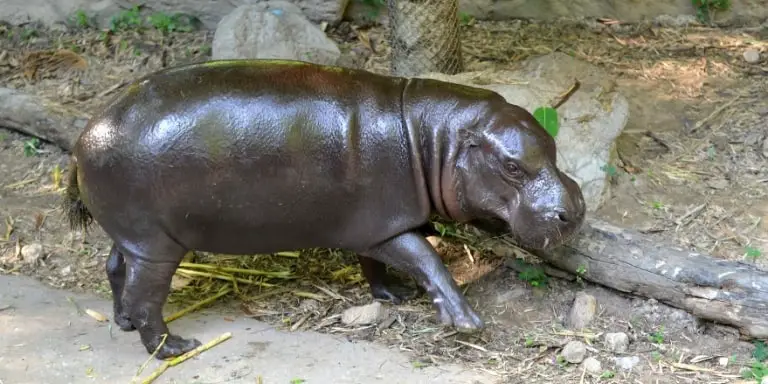
Reproduction
We know so little about pygmy hippos’ breeding mating in the wild. Hence, by far, our knowledge derives from captured animals. Females give birth on the ground or in deeper water. After delivery, the baby Hippo calves weigh around 5kg.
Usually, only one calf is conceived, although twins can occur on rare occasions. Mothers will hide their calves when foraging for food. They begin to obey their mother when they are around 3-5 months old. The young are weaned by approximately eight months of age, although they may remain with their mother for many years.
Conservation of Pygmy Hippos
This wildlife ecosystem is becoming more accessible to human predators. Food shortages due to agricultural restrictions, a shortage of utilities, and inadequate water services have culminated in the exploitation of forest resources as citizens struggle to satisfy their families’ food needs.
Pygmy hippo meat is tastier than meat from more giant hippos, so shooting continues through legal restrictions.
Despite being illegal in Liberia and despite a government drive to raise the consciousness of the high conservation expense, the bushmeat trade continues to prosper in major towns across the region.

Cost and maintenance

It costs approximately 50 cents a pound for harvested vegetables. So, it would run about $ 50 per day, totaling $ 18,250 per year. They come out of the water at night to eat and feed up to 100 pounds in one night! Because of their rarity, pygmy hippos are very costly.
To maintain a conduce environment for pygmy hippos, an enormous water supply is required which costs $ 150,000 in labor for a 20-acre pool. Assuming you own the property, a reliable source estimates that it is worth about $100,000. They are not inexpensive. They are highly costly and extremely uncommon.
Adoption of a Pygmy Hippo under US legislation
Different states in the US have various rulings governing whether pygmy hippos are permitted, prohibited, or include a special permit. Some states, such as Alabama, do not need any licensing or permits to adopt animal.
Other states, such as Alaska, Kentucky, and Pennsylvania, require a permit to own endangered animals that are classified as exotic species by the authority. In the middle of these two extremes, some states show leniency for adopting Pygmy Hippos. States like Indiana do not bar any animals for keeping as pets, given some certain conditions.
If you are willing to keep Pygmy Hippos on behalf of a zoo, sanctuary, or other approved facility, it is better to go to your local government and seek their assistance.
Future of Pygmy Hippos
Red List of IUCN enlisted pygmy hippos as endangered species. Even though this species is listed as Integrally Protected, wildlife regulations are ineffective in protecting the few remaining pygmy hippo populations.
A similar threat is that little is known about the basic life cycle, biology, ecology, and anatomy of wild pygmy hippopotamuses. Because of this awareness deficit, it is challenging to implement adaptive conservation schemes.
Conclusion
Many people want to adopt pygmy hippo at home. Unfortunately, their notorious nature of being violent and invading makes them not suitable to pet. Needless to add, it is not a pet for the household. As far as we are concerned! They are not the kind of dogs you should have in your backyard.
Related Posts:
Do hippos live in the jungle?
What color is hippo breast milk?
